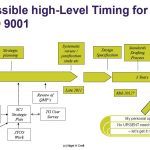In going through my old files on ISO 9001:2015, I came across a presentation given by ISO TC176 SC2 Chairman Nigel Croft at the 10th IRCA Forum in Japan, during June of 2011. There’s a lot of interesting information in it, but one slide in particular stood out.
For those of you who don’t know, Dr. Croft is a chief architect of the new ISO 9001 standard, heading up the subcommittee responsible for its development. While he backpedals when taking personal responsibility for it, opting to take a more diplomatic and democratic tone, he is — for better or worse — ISO’s top spokesman for the new standard. Dr. Croft has given multiple speeches, webinars and written articles on the new standard. His most recent webinar was hosted by registrar DNV. Dr. Croft has also formed an ISO 9001 consulting group, The Croft Alliance (TCA Global), for which he signed on a large number of TC 176 contributors.
As you know, through the Public Call document, Oxebridge has expressed a need to slow down on the development and publication of ISO 9001:2015, in order to address some key concerns. These included a lack of development of the Quality Principles (QPs) prior to starting drafting of the standard, and intense negative feedback from key industries on the leaked ISO 9001:2015 Working Draft, as well as criticism of the development process. ISO rejected the call for a pause, insisting that nothing is awry, and has pursued a publication date that was established as far back as 2010, without consideration of any obstacles or speedbumps that might arise. Some have called this the worst case of project management in ISO history.
But back in 2011 — only two years ago — Nigel Croft was presenting a very different story. According to a slide from his presentation, the 2015 was not fixed, and possibly up for reconsideration. A note indicates that his “personal opinion” was that the standard should not be rushed, but instead indicated a need to “get it right.” This same position was the one rejected by TC 176 Chair Gary Cort, when Oxebridge presented it.
Another interesting detail of the map presented by Dr. Croft is that he indicated the Quality Principles were intended to be completed before drafting of the ISO 9001 standard itself commenced, with the QPs to be completed by “Late 2011” before the Design Specification was completed. As we now know, the QP’s were actually delivered to the SC2 group sometime in early 2013, at which point two Working Drafts were already completed, and work on the first Committee Draft was nearing completion.
A similar “weirdness” appeared related to Dr. Cort’s understanding of what, exactly, the working group tasked with developing the QPs was doing. In his letter to Oxebridge, he insisted the QP’s were being provided on time, but that contradicted both first hand accounts of actual working group activities and official ISO memos on the matter. The best possible interpretation of this wide gulf between statements by TC 176 top brass and the facts would point to ineffective leadership. A worse interpretation is that this isn’t about putting out a good standard at all, provided the leadership can rake in consulting dollars later. (Gary Cort operates a consulting firm similar to that of Nigel Croft.)
We are left to wonder who, then, is pulling the strings, if not the Chair of TC 176 (Cort) nor the Chair of SC2 (Croft). Regardless of the answer, if ISO 9001:2015 fails to deliver — which is the expected result — their names will be permanently affixed to the resulting disaster.
Christopher Paris is the founder and VP Operations of Oxebridge. He has over 35 years’ experience implementing ISO 9001 and AS9100 systems, and helps establish certification and accreditation bodies with the ISO 17000 series. He is a vocal advocate for the development and use of standards from the point of view of actual users. He is the writer and artist of THE AUDITOR comic strip, and is currently writing the DR. CUBA pulp novel series. Visit www.drcuba.world








